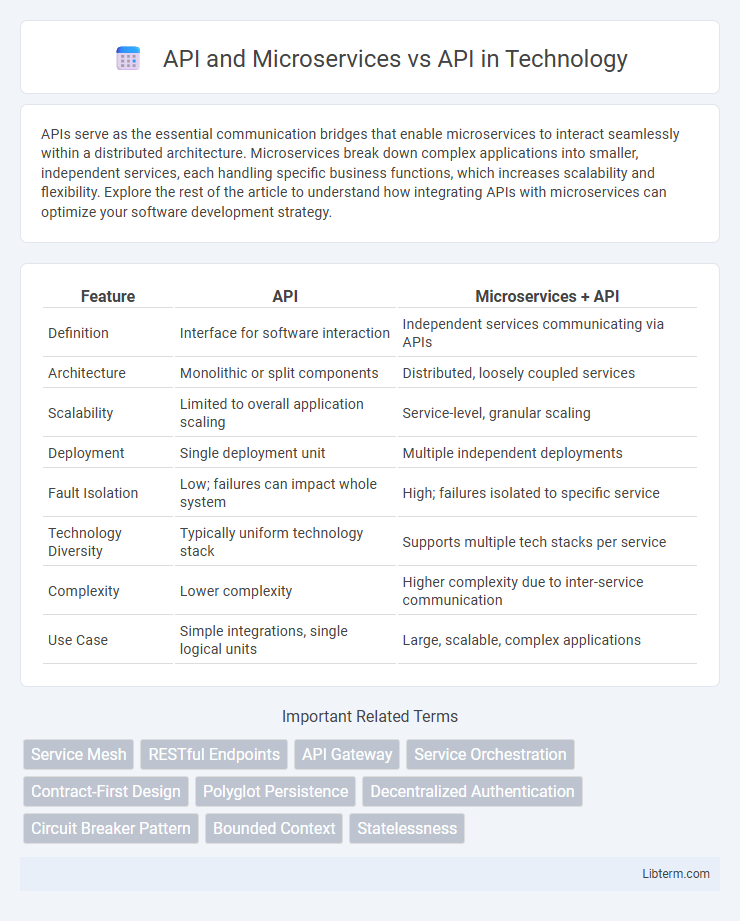APIs serve as the essential communication bridges that enable microservices to interact seamlessly within a distributed architecture. Microservices break down complex applications into smaller, independent services, each handling specific business functions, which increases scalability and flexibility. Explore the rest of the article to understand how integrating APIs with microservices can optimize your software development strategy.
Table of Comparison
| Feature | API | Microservices + API |
|---|---|---|
| Definition | Interface for software interaction | Independent services communicating via APIs |
| Architecture | Monolithic or split components | Distributed, loosely coupled services |
| Scalability | Limited to overall application scaling | Service-level, granular scaling |
| Deployment | Single deployment unit | Multiple independent deployments |
| Fault Isolation | Low; failures can impact whole system | High; failures isolated to specific service |
| Technology Diversity | Typically uniform technology stack | Supports multiple tech stacks per service |
| Complexity | Lower complexity | Higher complexity due to inter-service communication |
| Use Case | Simple integrations, single logical units | Large, scalable, complex applications |
Understanding APIs: The Digital Connectors
APIs serve as essential digital connectors that enable different software systems to communicate efficiently, facilitating seamless data exchange and functionality integration. Microservices architecture leverages APIs to break down applications into independent, modular services that improve scalability and agility. Understanding APIs is crucial for designing robust microservices and optimizing interoperability in modern software ecosystems.
Microservices Architecture: Key Fundamentals
Microservices architecture breaks down applications into loosely coupled, independently deployable services, each with a specific business function, enabling scalability and faster development cycles. APIs act as the communication layer, allowing these microservices to interact seamlessly through well-defined interfaces such as REST or gRPC. Key fundamentals include decentralized data management, continuous integration and deployment (CI/CD), fault isolation, and domain-driven design, which together facilitate agility and resilience in complex systems.
API Alone vs API with Microservices
APIs alone serve as interfaces allowing software applications to communicate and exchange data efficiently, often centralized and monolithic in design. APIs integrated with microservices enable modular, independently deployable services that enhance scalability, fault isolation, and continuous delivery. This combination supports diverse technologies and faster innovation cycles, reducing the complexity and risks associated with monolithic API architectures.
Core Differences: Monolithic APIs vs Microservices APIs
Monolithic APIs consolidate all functionalities into a single, tightly-coupled system, which can lead to scalability and maintenance challenges. Microservices APIs decompose applications into independent, loosely-coupled services, enabling greater flexibility, scalability, and easier deployment. Core differences include modularity, with microservices promoting distributed development and focused services, while monolithic APIs emphasize centralized architecture and unified codebases.
Scalability: Microservices APIs vs Standalone APIs
Microservices APIs enhance scalability by distributing workloads across independently deployable services, allowing each component to scale based on demand without affecting others. Standalone APIs, limited to a single application boundary, face challenges scaling efficiently under heavy loads due to their monolithic structure. The decoupled nature of microservices APIs offers granular resource allocation and fault isolation, driving superior scalability compared to traditional standalone APIs.
Flexibility and Maintenance: Microservices Impact
Microservices architecture enhances flexibility by breaking down applications into loosely coupled, independently deployable services, each with its own API, facilitating targeted updates and scalability. This approach improves maintenance by isolating issues within specific microservices, reducing the risk of widespread system failures and enabling faster troubleshooting. The API serves as a contract between microservices, ensuring seamless communication while allowing individual services to evolve without impacting the entire system.
Security Considerations: API vs Microservices APIs
APIs and Microservices APIs both require robust security measures, but Microservices APIs often demand enhanced protection due to their distributed nature and increased attack surface. Implementing strong authentication, authorization, and encryption protocols is crucial to safeguard inter-service communication within microservices architectures. Centralized security management tools like API gateways provide essential monitoring and threat mitigation, ensuring secure interactions across multiple microservices endpoints.
Performance Optimization in API and Microservices
API and microservices architectures significantly enhance performance optimization by enabling modular, scalable, and distributed system designs that reduce latency and improve resource utilization. Microservices allow independent scaling and deployment of specific services, which optimizes API responsiveness and minimizes downtime in complex applications. Implementing strategies like load balancing, caching, and asynchronous processing within APIs and microservices further boosts throughput and reduces response times, resulting in more efficient performance management.
Use Cases: When to Choose API, Microservices, or Both
APIs are ideal for enabling communication between distinct software systems, such as integrating third-party services or exposing functionality to external developers. Microservices architecture suits complex, scalable applications requiring modular development and independent deployment of services, like large e-commerce platforms or financial systems. Combining both allows granular service decomposition with external accessibility, supporting scenarios where internal microservices need API endpoints for integration and external consumption.
Future Trends: API Evolution with Microservices
API evolution with microservices is driving future trends by enhancing scalability, flexibility, and faster development cycles. Microservices architecture enables APIs to become more modular and independently deployable, supporting continuous integration and delivery. Emerging trends include API gateways, service mesh integration, and event-driven APIs, which optimize microservices communication and improve system resilience.
API and Microservices Infographic

 libterm.com
libterm.com